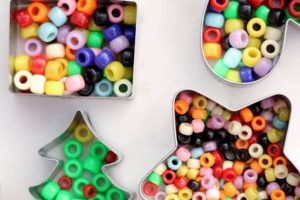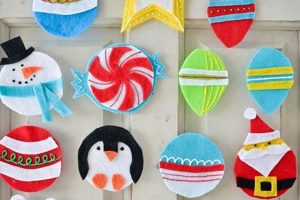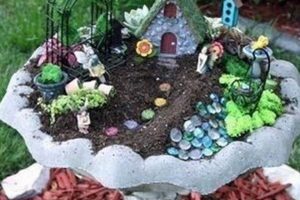The creation of festive decorations from basic paper materials allows for personalized holiday embellishments. These handcrafted items offer a cost-effective and creative alternative to commercially produced ornaments. Examples include paper snowflakes, origami figures, and quilled designs shaped into holiday symbols.
The practice of fashioning decorations from paper provides numerous advantages. It fosters creativity, utilizes readily available resources, and reduces environmental impact through repurposing materials. Historically, homemade decorations have been a significant part of holiday traditions, reflecting cultural values and artistic expression across generations.
The following sections will explore specific techniques for constructing various styles of paper-based ornaments, including instructions for folding, cutting, and assembling them. Furthermore, guidance will be provided on selecting appropriate paper types and adding decorative embellishments for a polished final product.
Crafting Refined Holiday Decorations from Paper
Achieving professional-looking results when creating holiday decorations from paper necessitates careful attention to detail and material selection. The following guidelines offer insights for improving the quality and longevity of handcrafted ornaments.
Tip 1: Select High-Quality Paper: Opt for acid-free paper to prevent yellowing and degradation over time. Cardstock provides increased durability for ornaments intended for long-term use.
Tip 2: Utilize Precision Cutting Tools: Employ sharp scissors or a craft knife with a self-healing cutting mat to ensure clean, accurate cuts, especially for intricate designs.
Tip 3: Reinforce Delicate Elements: Apply clear adhesive or laminating film to fragile components, such as thin paper snowflakes, to enhance their structural integrity.
Tip 4: Employ Secure Adhesives: Choose adhesives designed for paper crafts that offer a strong bond without causing discoloration or warping. Consider double-sided tape for a clean, seamless finish.
Tip 5: Protect Against Moisture: Apply a sealant or varnish to protect the finished ornament from humidity and potential water damage, particularly if it will be displayed outdoors.
Tip 6: Incorporate Weighting Elements: Add small weights, such as beads or metal washers, to the base of ornaments to improve stability and prevent them from tilting or falling.
Tip 7: Ensure Symmetrical Construction: When folding paper, precise alignment is crucial for achieving symmetrical designs. Use a bone folder to create crisp, clean creases.
Adhering to these guidelines will contribute to the creation of durable, visually appealing ornaments. Proper material selection and construction techniques are key to producing handcrafted decorations that will endure for many holiday seasons.
The subsequent sections will delve into specific design patterns and advanced techniques for further refining the creation of festive decorations from paper.
1. Paper selection
Paper selection directly influences the durability, aesthetic appeal, and suitability of handcrafted holiday decorations. The properties of the chosen paper, such as weight, texture, and color, dictate the ornament’s structural integrity and visual presentation. Improper selection can result in ornaments that are fragile, prone to tearing, or lack the desired visual impact. For instance, using lightweight printer paper for complex origami ornaments will likely result in a flimsy and easily damaged final product, whereas cardstock or specialty paper designed for crafting provides the necessary robustness.
Considerations beyond structural integrity include the paper’s finish and color. Metallic or glitter paper enhances the festive appearance, while textured paper adds tactile interest. The choice of paper must align with the intended design and desired aesthetic. For example, creating delicate paper snowflakes benefits from using translucent vellum paper to capture and diffuse light. Conversely, robust paper, such as corrugated cardboard, provides a suitable base for rustic or three-dimensional ornament designs. The compatibility of chosen paper with adhesives and embellishments is also crucial. Some adhesives may cause certain paper types to warp or discolor, while some embellishments may not adhere properly to particular surfaces.
In summary, informed paper selection is a foundational element in the creation of successful paper ornaments. Overlooking this aspect can lead to compromised results and wasted materials. By carefully considering the physical properties, aesthetic qualities, and compatibility of different paper types, crafters can maximize the potential of their designs and produce ornaments that are both visually appealing and durable. The challenge lies in balancing artistic vision with practical considerations, ensuring the selected paper aligns with both the intended design and the demands of its creation.
2. Cutting precision
The accuracy of cuts directly impacts the final appearance and structural integrity of paper-based holiday decorations. Inaccurate cutting, even seemingly minor deviations, can compromise the symmetry, overall design, and aesthetic appeal. Examples include uneven edges on paper snowflakes, misaligned layers in multi-dimensional ornaments, and compromised interlocking mechanisms in complex paper constructions. The sharpness of tools, steadiness of hand, and adherence to precise templates contribute to the quality of the cut. Therefore, cutting precision is not merely a procedural step but an integral component affecting the visual and structural coherence of the handcrafted result. Deviation from accuracy can introduce unintended flaws, potentially requiring rework or resulting in a less satisfying finished product.
Furthermore, specific designs rely heavily on precise cuts for functionality. Pop-up paper ornaments, kirigami designs (Japanese paper cutting), and layered silhouettes depend on accurate incisions for proper deployment of their three-dimensional elements. In these cases, cutting errors can prevent the ornament from functioning as intended or compromise its stability. Templates, stencils, and cutting machines serve as aids to increase precision, particularly for intricate patterns. Utilizing appropriate cutting tools and maintaining a controlled working environment are also essential for achieving the desired level of accuracy.
In conclusion, cutting precision is a crucial determinant of the quality of handmade paper decorations. Its impact extends beyond mere aesthetics, affecting structural integrity and functional elements of design. The mastery of cutting techniques, combined with appropriate tools and careful execution, is essential for producing ornaments that meet desired standards of craftsmanship and visual appeal. Overlooking this aspect introduces the risk of compromised results, ultimately detracting from the overall success of the decorative creation. Therefore, it is crucial for paper crafters to emphasize precision, technique and tools when crafting their unique paper ornaments.
3. Folding techniques
The manipulation of paper through folding constitutes a core method in the creation of many handcrafted holiday decorations. Folding techniques, ranging from simple creases to complex origami sequences, determine the form and structure of the resulting ornaments. The precision and accuracy of these folds directly influence the aesthetic appeal and structural stability. Incorrectly executed folds can lead to misshapen ornaments or a collapse of the intended design. For example, creating a traditional origami star requires a series of accurately executed folds to achieve the desired symmetrical shape and three-dimensional form. The mastery of these techniques provides the foundational skills for crafting various paper-based ornaments.
Specific folding methods are suited to particular designs. Simple fan folds create the foundation for paper medallions, while accordion folds form the base of paper snowflakes. Advanced origami techniques allow for the creation of intricate animal figures or geometric shapes, transforming flat sheets of paper into complex three-dimensional objects. The choice of paper weight and texture also plays a role in the success of the folding process. Thicker paper holds creases better, while thinner paper allows for more intricate folds. Creasing tools, such as bone folders, aid in achieving sharp, clean folds, contributing to the overall polished appearance of the ornament. Without proficiency in varied folding, the range of achievable designs is limited.
In summary, folding techniques are fundamental to transforming paper into decorative holiday ornaments. The successful execution of these techniques directly affects the ornament’s appearance and durability. Skillful application of these methods, combined with suitable paper selection, enables the creation of a diverse array of handcrafted embellishments. Mastering these techniques represents a critical skillset for any individual engaging in paper crafting for decorative purposes.
4. Adhesive usage
Adhesive usage constitutes a critical aspect in the construction of paper ornaments. The type and application of adhesive directly affect the structural integrity, longevity, and aesthetic appearance of the finished decoration. Inadequate adhesive application leads to delamination, separation of components, and ultimately, structural failure of the ornament. The choice of adhesive must align with the paper type, design complexity, and environmental conditions to which the ornament will be exposed. For example, constructing a multi-layered paper star requires an adhesive strong enough to bond multiple paper surfaces securely without causing warping or discoloration. Incorrect selection or application compromises the ornament’s durability and visual appeal.
Different adhesives provide varying levels of bonding strength, drying time, and finish. White craft glue, glue sticks, and double-sided tape represent common choices for paper crafting. White craft glue offers a strong, permanent bond but may require extended drying time and could potentially warp thinner paper. Glue sticks provide a cleaner application with quicker drying, but typically yield a weaker bond. Double-sided tape offers a seamless bond without drying time, ideal for precise assembly of intricate designs. The optimal adhesive depends on the specific requirements of the ornament design. Furthermore, the method of application significantly influences the outcome. Excessive adhesive can seep out from joints, creating a messy appearance, while insufficient adhesive results in a weak bond, causing components to separate. Precise and controlled adhesive application is, therefore, a necessity.
In summary, proper adhesive usage forms an indispensable part of the construction process. The selection of appropriate adhesives and meticulous application techniques directly influence the overall quality and resilience of the ornament. Insufficient attention to this crucial element results in compromised structural integrity and diminished aesthetic appeal. The paper crafter must, therefore, carefully consider the properties of various adhesives and apply them judiciously to ensure a durable and visually pleasing finished product.
5. Design complexity
Design complexity, within the realm of paper-based holiday decorations, directly influences the resources, time, and skill required for ornament creation. It encompasses factors ranging from the number of individual components to the intricacy of folding patterns and the precision of required cuts. The level of complexity chosen for a project directly impacts the accessibility and feasibility for a given crafter.
- Number of Components
The sheer number of individual pieces needed for an ornament directly correlates with its complexity. A simple paper star might consist of a single folded sheet, while a complex paper village ornament requires dozens of individually cut and assembled components. This increased component count necessitates more preparation time, higher material costs, and greater organizational skill to manage the various pieces during assembly. Complex designs can be overwhelming for novice crafters, potentially leading to frustration and abandonment of the project.
- Intricacy of Folding Patterns
Ornaments employing advanced folding techniques, such as origami or complex tessellations, introduce a significant level of complexity. These techniques require a thorough understanding of geometric principles and meticulous execution of each fold. A simple crease pattern is easily learned, whereas elaborate origami designs involve numerous steps and precise alignment for successful completion. Failure to accurately execute these folds results in a misshapen or unstable ornament. Advanced folding techniques demand a higher level of spatial reasoning and dexterity, potentially excluding beginners from attempting such designs.
- Precision of Required Cuts
Ornaments featuring intricate cut-out patterns, such as elaborate paper snowflakes or layered paper silhouettes, demand a high degree of cutting precision. Inaccurate cuts can distort the intended design, resulting in an aesthetically displeasing ornament. Intricate designs often necessitate the use of specialized cutting tools, such as craft knives or cutting machines, further increasing the complexity and cost of the project. The level of precision required can be challenging for individuals with limited manual dexterity or experience with cutting tools.
- Assembly Techniques
Certain designs incorporate complex assembly techniques. Stringing many small pieces together to create a garland or connecting intricate origami parts calls for precision. An error can cause the entire construction to collapse. More complex assembly steps could also lead to an increased need for specific supplies. This can make a project unviable to someone without proper access.
In conclusion, the level of design complexity plays a pivotal role in determining the accessibility and success of creating handcrafted paper decorations. Balancing the desired aesthetic with the available resources, skill level, and time constraints is crucial for a fulfilling and rewarding crafting experience. Choosing simpler designs or scaling back complex patterns might be preferable for beginners looking to enjoy the creative process without overwhelming technical challenges.
6. Finishing details
The final touches applied to handcrafted paper ornaments significantly enhance their visual appeal and perceived value. These elements elevate the ornaments from simple paper constructions to refined, personalized decorations, contributing to their overall impact.
- Application of Decorative Embellishments
The strategic addition of glitter, paint, or metallic accents transforms the appearance of plain paper ornaments. Glitter introduces a festive sparkle, while paint allows for color customization and the creation of intricate designs. Metallic accents provide a touch of elegance and sophistication. The application of these embellishments requires careful consideration of color palettes and the overall design aesthetic. Excessive or poorly applied embellishments can detract from the ornament’s appeal, while well-executed details enhance its visual impact and create a sense of polish.
- Sealing and Protective Coatings
Applying a sealant or varnish protects paper ornaments from moisture damage and fading, extending their lifespan and preserving their appearance over time. These coatings create a barrier against environmental elements, preventing the paper from warping or discoloring. Sealants also enhance the durability of the ornament, making it less susceptible to tearing or damage from handling. The choice of sealant depends on the type of paper and embellishments used. A matte sealant maintains a natural look, while a glossy sealant adds a sheen and enhances the vibrancy of colors.
- Attachment of Hanging Mechanisms
The method by which an ornament is hung significantly impacts its presentation and ease of use. Attaching a secure and aesthetically appropriate hanging loop or string ensures that the ornament hangs properly and remains securely attached to the tree. The choice of hanging mechanism depends on the size, weight, and style of the ornament. Simple ribbon loops, elegant metallic hooks, or delicate beaded strands represent common options. The hanging mechanism should complement the overall design of the ornament and provide a secure and reliable means of display. A poorly attached or unsightly hanging mechanism can detract from the ornament’s aesthetic appeal.
- Edge Finishing and Refinement
Refining the edges of paper ornaments enhances their overall appearance and prevents fraying or tearing. Techniques such as sanding, edge painting, or the application of decorative tape create a clean and polished look. Edge finishing is particularly important for ornaments with exposed paper edges, such as snowflakes or layered designs. Sanding removes any rough edges, while edge painting adds a touch of color and definition. Decorative tape provides a quick and easy way to finish edges and add a decorative element. These finishing touches contribute to a professional and refined final product.
In conclusion, careful attention to finishing details elevates handmade paper ornaments, enhancing their visual appeal and extending their lifespan. These final touches contribute to a polished and personalized decoration that reflects the skill and creativity of the crafter. Overlooking these elements diminishes the overall impact of the ornament, while well-executed details transform simple paper constructions into cherished holiday keepsakes.
7. Hanging method
The method by which a paper ornament is suspended is inextricably linked to its design and functionality. The chosen hanging method directly influences the ornament’s presentation, security, and overall aesthetic integration with its surroundings. A poorly selected or executed hanging mechanism can detract from the ornament’s visual appeal and, more critically, jeopardize its structural integrity, leading to breakage or damage. The weight of the ornament, the fragility of the paper material, and the intended display location all dictate the appropriate hanging method. For instance, a lightweight paper snowflake may require only a delicate thread, whereas a heavier, multi-layered paper star necessitates a more robust wire loop or reinforced attachment point to prevent tearing or detachment.
Practical considerations extend beyond simple attachment. The length of the hanging string or ribbon affects the ornament’s visual prominence and its positioning within the display space. A too-short string may cause the ornament to be obscured by branches, while an excessively long string could result in entanglement or damage. Moreover, the aesthetic properties of the hanging material must complement the ornament’s design. A rustic paper ornament might benefit from a natural twine or jute cord, whereas a more elaborate ornament may necessitate a satin ribbon or metallic thread. The method of attachment also requires careful attention to detail. A simple knot may suffice for lightweight ornaments, but heavier designs often require adhesive reinforcement or the use of eyelets to distribute stress and prevent tearing. Proper preparation of the hanging mechanism, including selecting appropriate materials and employing secure attachment techniques, is crucial for ensuring the longevity and visual impact of the ornament.
In summary, the hanging method is a critical, albeit often overlooked, component of paper ornament design. It directly influences both the aesthetic presentation and structural integrity of the decoration. Careful consideration of weight, material compatibility, and attachment techniques is essential for ensuring that the ornament is displayed securely and attractively, contributing to the overall festive ambiance. Neglecting this aspect undermines the craftsmanship invested in the ornament’s creation and increases the risk of damage or loss. The integration of a well-considered hanging method is thus paramount for realizing the full potential of handcrafted paper holiday decorations.
Frequently Asked Questions
This section addresses common inquiries and concerns regarding the creation and preservation of handcrafted paper Christmas ornaments.
Question 1: What paper types are most suitable for crafting durable Christmas ornaments?
Cardstock, heavyweight paper, and specialty craft paper offer increased durability compared to standard printer paper. Acid-free paper resists yellowing and degradation over time, ensuring longevity of the ornament.
Question 2: How can intricate paper ornament designs be cut with precision?
Employing sharp craft knives or precision scissors, in conjunction with cutting mats and templates, facilitates accurate cuts. Digital cutting machines offer enhanced precision for complex designs, albeit at a higher initial investment.
Question 3: What adhesive options are recommended for paper ornament construction?
Acid-free glue sticks, double-sided tape, and clear-drying craft glues provide secure bonding without causing discoloration or warping. The selection of adhesive should align with the paper type and the ornament’s structural requirements.
Question 4: How can paper ornaments be protected from moisture and environmental damage?
Applying a sealant or varnish creates a protective barrier against humidity and fading. Laminating individual components before assembly offers additional protection, particularly for ornaments intended for outdoor display.
Question 5: What methods exist for reinforcing delicate paper ornament components?
Backing fragile elements with cardstock or applying multiple layers of paper provides added structural support. Clear adhesive films or laminating sheets reinforce delicate features without obscuring the design.
Question 6: How can paper ornaments be properly stored to prevent damage between holiday seasons?
Store ornaments in acid-free tissue paper within a sealed container to protect them from dust, moisture, and physical damage. Avoid stacking heavy items on top of ornaments to prevent crushing or deformation.
Proper material selection, construction techniques, and storage practices are crucial for creating and preserving paper Christmas ornaments. Adherence to these guidelines ensures enduring beauty and enjoyment of these handcrafted decorations.
The following section will provide insights into various design inspirations and creative approaches for crafting unique paper Christmas ornaments.
DIY Christmas Ornaments with Paper
This exploration has addressed the multifaceted nature of crafting decorations from paper. Key aspects, including paper selection, cutting precision, folding techniques, adhesive usage, design complexity, finishing details, and hanging methods, have been examined to illuminate their impact on the final product. Understanding these elements is crucial for those seeking to create durable and visually appealing ornaments.
The creation of paper decorations offers a creative avenue for personal expression during the holiday season. Continued refinement of techniques, combined with innovative design approaches, will ensure the sustained relevance of this craft. The principles outlined herein provide a foundation for both novice and experienced crafters to enhance their skills and contribute to the ongoing evolution of this artistic practice.







